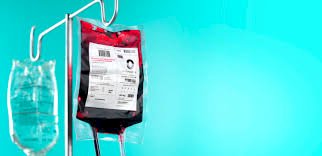PLASMA TREATMENT
“White cells are best hunters” Global scientist are taking step towards finding vaccine to completely destroy the Novel coronavirus (COVID 19). In this situation plasma treatment is helping globally to keep the mortality rate low.

Before we see what is Plasma treatment let us remember the true statement which says that The life of the flesh is in the Blood.
Our blood contains both solid and liquid particles. All the red blood cells, white blood cells and platelets are in solid state. The liquid state particles in our blood is called plasma.
More than half portion (55%) of our blood is Plasma.
The liquid state plasma is a pack of proteins plus glucose which helps our body to carry all the blood cells from top to bottom.

Diagram shows the Extracted plasma from blood cells
Normally our immune system will work against the virus and bacteria which infecting us. white blood cells are taking major role in this battle. When we affected by normal virus and bacteria’s (previously affected), the normal antibodies in our own body will defend us from them. These micro soldiers are placed in plasma.
For this antibodies it is easy to identify those normal virus and already practiced to defeat them.
The problem is the corona virus is a new for whole humanity. So when a human affected by new virus, in his body it may take time to form antibodies naturally, scientists says.
The person who already get cured from these new virus because of their strong immunity power, they would have antibodies which have the capacity to identify that new virus and defeat them.
So, plasma treatment is a process of artificially increasing the immune power by injecting the cured persons plasma (which extracted from his blood) into the infected person.
This method of treatment is called plasma treatment. The methodology used to extract the plasma from blood is called centrifugation.

Today this plasma treatment is available in many countries including India.
When was the Convalescent Plasma Therapy first time used?
The concept dates back more than a century that is in 1890 when a German physiologist Emil von Behring discovered that when he took the serum from an infected rabbit with diphtheria, it was effective in preventing the infection caused due to diphtheria.

In the past, same types of treatments are used during several outbreaks, including Spanish flu pandemic 1918, the diphtheria outbreak 1920, etc. That time convalescent therapy was less effective and had substantial side effects.
The therapy was recently tried for Ebola virus and other coronavirus diseases like SARS in 2003 and MERS in 2012. The method was used with improved extraction and screening techniques and appears to be more safe and effective than ever before.
How does Convalescent Plasma Therapy work?
In this technique, the blood is ejected from the recovered patient from COVID-19. Thenthe serum is separated and screened for virus-neutralising antibodies. The antibodies rich serum is then administered to a COVID-19 patient showing severe symptoms.
According to Houston Methodologist, the process takes around one hour for donating plasma just like to donating blood. It is said that the donors of the Plasma are hooked up to a small device that removes plasma while simultaneously returning red blood cells to their bodies. In regular blood donation, donors have to wait for red blood cells to replenish between donations but in the case of plasma, it can be donated frequently, that is twice a week.
The plasma rich with antibodies is taken from the recovered patients of COVID-19 and then is infused into the bloodstream of other infected coronavirus patients. When the body gets into contact with external pathogens like bacteria or germs, it automatically starts a defence mechanism and started releasing antibodies.
According to the researchers, the therapy is not as simple as to obtain a significant amount of plasma from survivors is difficult. In the case of COVID-19, a new disease, where most patients are aged and already suffering from other diseases like hypertension, diabetes, etc. Therefore, effectiveness remains questionable.
Various trials and studies related to Convalescent Plasma Therapy:
In China, a study found the therapy as effective, on small sample size, in treating COVID-19 patients. In the study, it was given that a trial was conducted in which 200 ml dose of convalescent plasma was administered to 10 adult COVID-19 patients with severe symptoms. The patients showed significant improvement and in seven patients virus disappeared without any severe adverse side effects. In this therapy, the sick acquires only temporary passive immunisation. It last mainly less than a week that is till the time the injected antibodies remain in the bloodstream.
In Houston also, the same trial was conducted and it is said that three critical ill COVID-19 patients are also showing signs of recovery from the convalescent plasma therapy.
According to the US Food and Drug Administration (FDA), prior experience with respiratory viruses and the data that have emerged from China shows that the therapy has the potential to lessen the severity or shorten the length of illness caused by COVID-19.
In India, the Indian Council of Medical Research (ICMR) has given the nod to Kerala to conduct convalescent plasma therapy. Kerala is the first state to start clinical trial of plasma therapy in the country. ICMR has not yet recommended it as a treatment option outside of clinical trials.

Several countries including China, South Korea, US and UK have also tried this therapy treatment. Some leading medical journals say that initial small trials are encouraging. Trials and researches are going for COVID-19 treatment. Therefore, it is necessary to take precautions as per the advisory of the government. Stay home and be safe!
Who all can donate plasma and when?
All those who have recovered from COVID-19 and are between the ages of 18 – 60 years and weigh not less than 50kgs can be considered 14 days after their recovery. Most doctors advise a time of three weeks between recovery and plasma donation.
Women who have just delivered and people with comorbidities such as diabetes, hypertension, weakened lungs and cancer are excluded. Extensive medical checks are done to ensure no harm both to the donor or the recipient. The donated blood is also checked to exclude risks of it having any other disease-causing agents such as Hepatitis B, Hepatitis C, HIV etc.
How much plasma is removed from a donor and how many patients are benefitted by one donation?
Depending on the wright of the donor, the bank collects 500 ml of plasma. Each plasma donation would be used to treat 2 patients.
When is plasma therapy most useful?
Medical experts using this experimental therapy say plasma works better when administered early in the disease cycle, as it can then boost immunity. Dr Randeep Guleria Director of AIIMS had told CNBC-TV18 that giving antibodies in late stage may not be useful. However, it is not a magic bullet, he says. So, giving plasma therapy to moderately ill patients, who are not responding to oxygen therapy may help slow down the deterioration of the patient.
Are there enough plasma donors available?
Plasma donors are recovered COVID-19 patients who fit the criteria based on their medical condition and other factors. The stringent eligibility conditions excludes many among recovered patients and reduces the pool of donors to a relatively small one. Besides, plasma therapy is a voluntary activity and depends on the willingness of the recovered patient to donate his/her plasma. This is making finding a willing donor tough. Both Delhi and Maharashtra state governments have launched awareness drives and programs to motivate more and more recovered patients to donate their plasma.

Is plasma therapy an approved and proven COVID-19 therapy?
Medical experts across the world are experimenting with plasma therapy in moderate to critical COVID-19 patients and some success has been seen so far. However, it has yet not been conclusively proven as an effective treatment for COVID-19.
As of now in India convalescent plasma therapy has been approved as an “off-label” therapy, meaning as an “investigational therapy” and only under certain conditions. The government’s clinical management guidelines say convalescent plasma may be considered in patients with moderate disease who are not improving (oxygen requirement is progressively increasing) despite use of steroids.
While some evidence of viral load reduction is seen and some patients receiving plasma have recovered, critical care specialists have cautioned that enough data is still not available to vouch for its efficacy. Instances of the patient’s condition worsening have also been reported.
Indian government guidelines make it clear that the use of the therapy is “based on limited available evidence”. While the therapy is approved as an investigational treatment, even outside clinical trials, a June 25 advisory on blood transfusion by the National Blood Transfusion Council under the Ministry of Health had cautioned against the use of plasma therapy as routine treatment. Clinical studies to ascertain the efficacy of the therapy are still ongoing.
What studies are currently underway on Plasma therapy?
A small study in China early on in the COVID-19 pandemic showed a few critically ill patients in China improved with plasma therapy.
In India, the therapy was first explored on a Covid-19 patient in April by Max Healthcare in Delhi. The patient recovered.
World over, more than 200 clinical trials to prove the safety and efficacy of plasma therapy in treating critical COVID-19 patients have been registered. In India, currently, 11 clinical trials are ongoing on plasma therapy.
The Maharashtra government has launched Project Platina touted as the world’s largest plasma therapy trial. Under this free plasma therapy will be provided at 21 government-run centres in Maharashtra, including four in Mumbai. Initially, it will start with 13 centres with a goal to two doses of 200 ml supply of plasma taken from recovered patients will be given to 500 current patients. The plan is to gradually ramp up to 5,000 by August.

Is plasma therapy completely safe?
It is otherwise considered a relatively safer therapy. However, a recent study by John Hopkins immunologists flagged some of the risks associated with it. As the blood transfusion takes place, there are risks that an inadvertent infection might get transferred to the patient. The therapy might fail for some patients and can result in an enhanced form of the infection, a condition called 'antibody dependent enhancement'.
The antibody administration may end up suppressing the body's natural immune response, leaving a COVID-19 patient vulnerable to subsequent re-infection.
Has plasma therapy been used in the past?
The therapy is almost a hundred years old when physician Dr Emil Behring first demonstrated that plasma could be used to treat diphtheria. He was awarded the first Nobel prize for physiology and medicine for his work. The therapy has been experimented in coronavirus outbreaks in the past, during the first Sars epidemic in 2003, later was also tested during the Ebola virus outbreak in 2013-2016. During this time only a few observational studies were conducted that showed promising results and no evidence of serious complications. However, no large-scale randomised trials, which is considered the most reliable method of establishing efficacy of a treatment, were performed.
What's Your Reaction?















